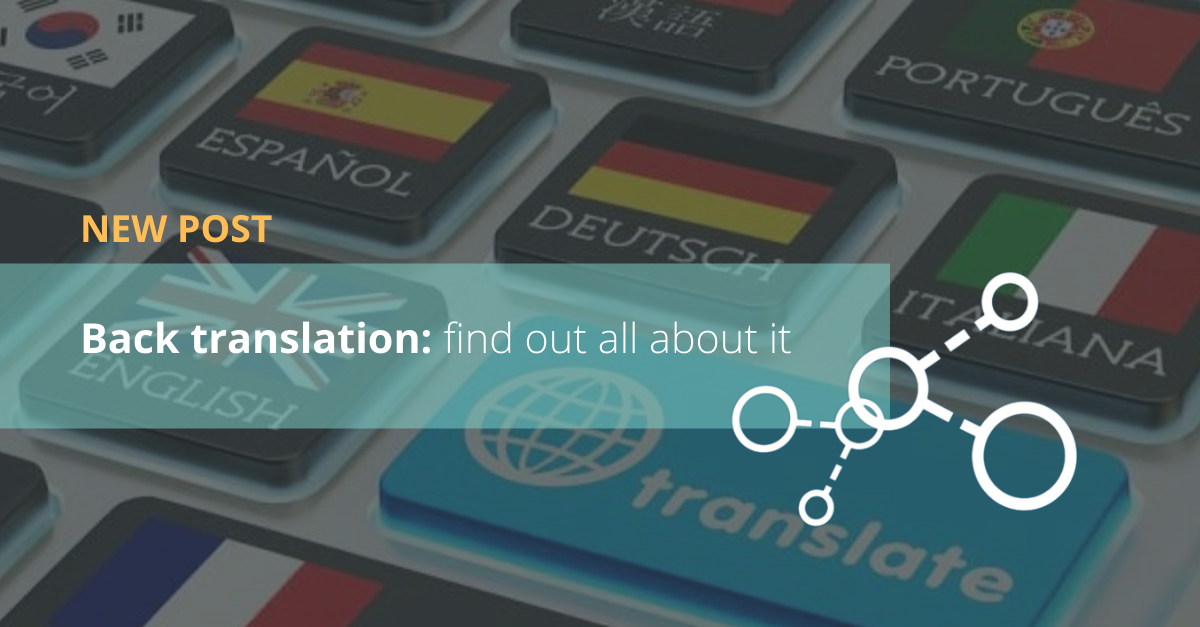Back translation or reverse translation consists of translating back into the original language in order to ensure the accuracy or literalness of a translation. It is generally used to check the quality and accuracy of the translation of content considered critical or high-risk.
What is back translation and how is it performed?
Back translation is a procedure by which a translator, or team of translators, interprets or re-translates a document that was previously translated into another language. In other words, a round trip to the original language is made in order to verify the quality of the translation.
Reverse translation is usually performed by a translator who was not previously involved in the original translation into the target language. Therefore, this professional has no prior knowledge of the objectives of the text or their specific context, meaning a back translation will never be 100% the same as the original text.
It is a translation technique used as a quality assessment tool, which can be used by clients, translation agencies or freelance translators.
The main objective of a reverse translation is to provide a description as accurate and literal as possible of the exact meaning of the translation in the target language. By doing so, errors that can be fatal in certain texts of great importance, which are often used as the basis for making important decisions in various fields, are avoided.
Stages of a back translation process
Normally, a back translation process works as follows:
- First, a translator translates the text from the original source into the target language.
- Subsequently, a different translator translates the resulting text back into the source language.
- The content owner, or whoever commissioned the translation, compares both texts in the original language and makes sure the meaning coincides or, failing that, detects possible translation errors.
Main uses of back translation
The revision of a translation through a back translation process helps to detect and correct any errors, confusion or ambiguity that may arise as a result of the different nuances of each language, helping to assess the equivalence of meaning between the source and target texts.
By comparing the back translation with the original text, the quality and accuracy of the translation can be confirmed. This is especially important for content where every detail is critical and quality assurance, precision and accuracy are required.
For what type of documents is back translation used?
In principle, any high-value text can benefit from including back translation as part of the translation process. However, it is generally used for critical and high-risk content, where translation accuracy is paramount and any error could have major consequences.
Some fields, sectors or activities where back translation is very common are:
- Medical translations: drugs, treatments, device performance, research, clinical trials, forms and consents.
- Pharmaceutical companies.
- Scientific material.
- Packaging of export products, especially foodstuff.
- Contracts and legal instruments.
- Financial reporting.
- Surveys, questionnaires and marketing reports.
- Translations for government agencies.
Related content: How to protect your data with data masking
When to use back translation services?
In general, back translation services are used in texts where a very high level of accuracy and detail is required to avoid errors, misunderstandings and ambiguities that can lead to serious mistakes; for example, the misuse of a medical device, an incorrect formulation of a drug or a misinterpreted conclusion of a financial report.
Back translation is also fundamental in the international relations between different governments and administrations. In these cases, back translation may be mandatory in order to comply with certain legal requirements.
It is also useful for content that, while not overly technical, includes slogans, titles, product names, clever phrases and puns where the implied meaning or intent of the content in one language does not necessarily work or does not have the same equivalence in a different language.
You might be interested in: Services that every translation company should offer
Alternatives to back translation
It should be noted that a professional translation that includes a back translation service is more costly and time-consuming, since it is more complex and involves more people and/or more working hours. Therefore, you should assess whether back translation is really necessary or mandatory by regulation before requesting it.
An alternative is double translation, a system in which a translator creates multiple versions of a piece of content to detect and highlight nuances in different words and phrases.
It is also possible to review the texts written in the original language, with the aim of facilitating the translation and indicating the terms that may give rise to errors or confusion. If the person, company or institution that needs the translation has professionals who are native speakers of the language or have sufficient knowledge of it, it is possible that such prior review may be sufficient for them to carry out their tasks; or they may be able to translate the previously reviewed text themselves.
At Pangeanic, we are specialized in the implementation of innovative solutions based on artificial intelligence and data analysis applied to machine translation, with special attention to anonymization and scalability.
We have been able to effectively combine human intelligence and advanced technology that enables us to perform cognitive and adaptive machine translations without errors and with a near-human quality. Another of our facets is knowledge extraction from all types of content, structured and unstructured, in order to obtain actionable information with all the privacy and data protection guarantees.




